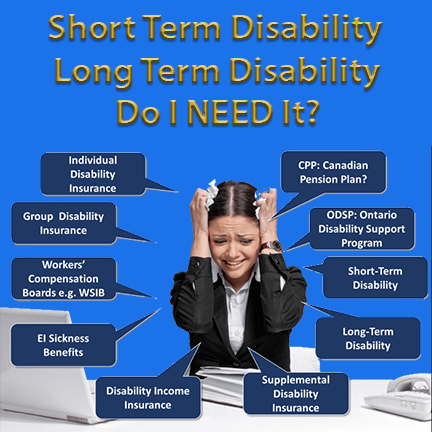What is long-term disability insurance and do I need it!

You bet! If you get injured, become sick, or are involved in an accident and can’t work for any reason, you need long-term insurance to keep money coming in. What would you and your family do without your income coming in right now?
My friends and I were merrily driving down the highway, looking for an early game of golf and some fun when — bang! A guy came out of nowhere around a blind corner, going 120 km/h in a 40 km/h zone, totally in my lane. He had been passing people by crossing over double solid lines for miles. The police had already been notified about him.
That didn’t help us! It took 1.5 hours to cut me out with the jaws of life, my ankle was crushed, and we had many more injuries: my friend had a cracked and broken wrist, my wife had internal injuries, and my friend’s wife became a quadriplegic. My wife and I were in hospitals and recovery for many months — with no workers compensation because we weren’t at work.
Studies show that a 20-year-old worker has a 1-in-4 chance of becoming disabled before reaching full retirement age. In Canada, chances are you will be disabled for three months or more before the age of 50.
According to the U.S. Bureau of Labor, “in 2018, 42% of private industry workers had access to short-term disability insurance plans and 34% to long-term plans. Twenty-six percent of state and local government workers had access to short-term coverage and 38% to long-term benefits.”
What does that mean? It means that for a lot of workers if they get injured or sick, they will have little or no money coming! If you own your own business, you cannot do without coverage.
The insurance policy that you choose will pay a monthly cash benefit to help pay for everyday expenses.
What constitutes a disability?
The following are considered disabilities:
- physical injury that keeps you from performing your job or any occupation at all
- heart attack
- cancer
- stroke
- musculoskeletal disorders
- nervous system disorders and seizures
- injuries from an accident
- mental health problems
- major surgery
- in some cases, childbirth
- mood disorders, including bipolar, anxiety, or depression
- PTSD
- fractures
- brain injuries
- arthritis and rheumatoid arthritis
- diabetes
- multiple sclerosis
- lupus
- fibromyalgia and chronic fatigue syndrome
- infection
- gastrointestinal illness (Crohn’s, colitis, irritable bowel syndrome, diverticulitis)
It is essential that you read the terms and have your insurance professional go over the partial and residual disability benefits with you.
What is the difference between short-term and long-term disability?
As covered, disability insurance is a policy that you or your company has on you in the event you get injured, sick, or in an accident. Sometimes the company pays, other times the company and the employees share the costs on a percentage basis, or you have personal coverage. Or, your disability is not job-related and you need time to recover from an injury, surgery, or other challenges.
In Canada, the Workers’ Compensation Act for each province requires employers to pay into the plan to cover their employees. The coverage would cover any work-related injury, illness, or disease. It is a little more complicated in the States. The federal Social Security Disability Insurance benefits are often optional, with the exception of five states and Puerto Rico. In fact, the state plans don’t cover anything till six months into a disability.
Short-term disability is usually defined as being off work for on average 26 weeks and pay between 50–67% of your income. They are normally written as 13, 26, or 52 weeks. In some cases, you can use your employment insurance to cover short-term disability.
Long-term disability looks at people who are injured, sick, or diseased for six months or longer and will pay between 50–70% of your income.
Important aspects to consider when choosing a disability insurance plan
How much will you get?
Read the fine print carefully. Many benefit plans cover a percentage of your income, but there may be a cap on the monthly benefit. Money Sense illustrates this beautifully:
When evaluating your plan, keep in mind that many disability plans include a cap on benefits. For instance, your plan may cover 60% of your gross income, but only up to $2,500 a month. That means if you’re earning more than $50,000 a year, you may not have enough coverage. If you made $130,000 annually, you would only get the $2,500 a month maximum, which amounts to only 23% of your pay.
If you earn a high income, you may want to consider a private disability plan to supplement your group benefits. To give you a quick idea of the cost involved, a private “own occupation” disability policy for a 40-year-old male white-collar non-smoker that pays $3,000 a month until age 65 (90-day waiting period) would cost about $140 a month. The same policy for “any occupation” would cost about $75 a month.
Is there an elimination period?
The cost of your policy is determined by how much you are insured for and how soon the benefits kick in. The elimination period is the time you must wait after being diagnosed with a debilitating injury to get your monthly cheque. In the short term, you would use your sick leave, vacation, or personal leave. For long-term disability, it is usually written as no wait, 30 days, 60 days, or 90 days.
How will you be taxed?
If you pay for your insurance coverage yourself, then your benefits are tax-free. If not, know what percentage of your gross income will be covered and how much taxes will be deducted from your benefit payment. You would need to check out how you will be taxed in various states and provinces.
What happens if you are permanently impaired?
You may qualify for a lump sum payment — know what it is.
How long will benefits last?
That depends upon how much you pay and what your coverage is. It usually is till 65 and can be more.
What are the exclusions?
What is not covered is often more important than what is covered — make sure you know what that is.
How many times can you make a claim?
Some policies allow you to claim for the same cause as long as it has been two years or longer since the completion of the first claim. Others let you claim for as long as you hold the policy, as long as they are different causes. Make sure that your policy is “guaranteed renewable.” That is, the ability to renew the policy without additional evidence.
Is there a Cost of Living Adjustments (COLA) clause?
If you are going to be on disability for a long time, you know the value of money will slowly erode, so it will be important to make sure the policy has a COLA clause in it. This is an annual adjustment to the payout by a set or variable increase in the payout to account for inflation.
Hopefully, I have impressed by the fact that no matter who you are and what your company will do for you, having additional long-term disability insurance is never a bad thing.
If you would like to talk and find out how I can help you, click here
